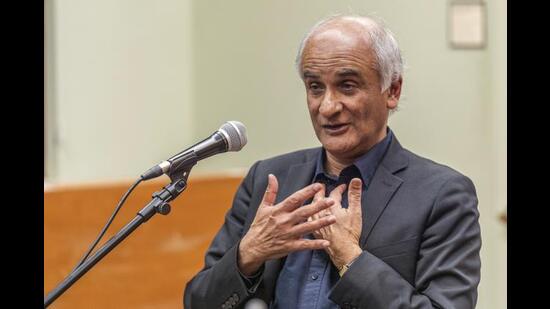Review: Learning From Silence by Pico Iyer
Pico Iyer’s latest book, which includes reflections drawn from three decades of retreats at a Benedictine monastery in California, is a call to engage more deeply with the world
Everything is burning, the Buddha told his disciples in what is now known as the Fire Sermon. Our senses, thoughts and consciousness are ablaze with the fires of delusion. The Bible, too, uses the metaphor of refining fires for the flames that test us. Such ideas may well have resonated with Pico Iyer during and after a devastating wildfire in July 1990 when his house in Santa Barbara, California, was reduced to ashes and debris.

Fortunately, he survived, and found solace in the realisation that material objects are less important than the internal resources of memory, relationships, and creativity. In his writings over the years, he has emphasised the importance of resilience and embracing impermanence.

His new book, Learning From Silence (which has the topical title of Aflame in the US), continues this journey. It is a series of memories and reflections drawn from over three decades of retreats at the New Camaldoli Hermitage, a Benedictine monastery in Big Sur, California, which itself has been threatened by wildfires over the years. Hushed, meditative, and questing — though occasionally solipsistic — the book echoes themes from some of his earlier works, such as The Art of Stillness.
The fragmented narrative revolves around his reactions to life in the hermitage, his interactions with monks and friends, and his ruminations on the beauty of silence and nature. These distilled contemplations are drawn from “literally thousands of pages of notes” written in “the most stimulating site I know”. He feels that “most of my life was contained in them”.
The silence of the monastery differs from that of a deep forest or mountaintop: “it’s active and thrumming, almost palpable.” At times, the outside world intrudes, with welcome as well as unwelcome news. At others: “Yesterday I thought myself at the centre of the world. Now the world seems to sit at the centre of me.”
He finds illumination everywhere: in ocean views, the vast starlit sky, and the words of others. These include the thoughts of Meister Eckhart; the revelations of Thomas Merton; hopeful readings of Nietzsche and Camus; and the verses of Emily Dickinson: “Wonder is not precisely knowing and not precisely knowing not.” One may need to read that line more than once.
Beyond books, there is solace and insight in conversations with others at the hermitage over the years. These are an eclectic mix of professionals, the self-employed, and the retired, with an ecumenical approach to faith. “One greets me with a Buddhist bow,” Iyer writes, “another with a Hindu namaste”. At this Benedictine shelter, “we’re not joined by any doctrine or mortal being or holy book; only by a silence that speaks for some universal intimation”.
There are also recollections of meetings with his old friend Leonard Cohen at the Mount Baldy Zen Centre. “Always in command, on point; and now, on this dark mountain, he carries himself like an anonymous grunt, scrubbing floors, cooking for the abbot, driving the old man to the doctor.” When Iyer suggests that Cohen comes to the Zen centre seeking answers, the gravel-voiced singer replies that it is a place where he finds freedom from questions and answers altogether, “a landscape without doubt”. Hallelujah.
Iyer also tackles the issues that must arise in the minds of those who embark upon such sojourns. He realises that he is among the privileged, and retreats don’t necessarily mean an escape from obligations and responsibilities. For him, a monk “is not someone who wishes to live peacefully and alone; in truth, he exists in a communal web of obligations as unyielding as in any workplace, and continuing till his final breath”. That moves well beyond stereotypes of isolated hermits.

Over the years, he grapples with concerns about his mother’s health, particularly after his father’s passing, as well as the well-being of his then partner, Hiroko, who lives with him in Japan. “Isn’t it selfish,” an old friend asks, “to leave your loved ones behind to go and sit still?” His reply: “Not if sitting still is the only way you can learn to be a little less selfish.”
Perhaps inevitably, there are times when some passages come across as little more than reminders to himself. The writing can also veer towards the grandiose: “All the scattered filaments inside of me come together in a singing whole.” At other times, he is simplistic: “We quote Wittgenstein all the time, and people are always talking about his books. But maybe it’s his silences, his disappearances, that really affect us in the end?”
Contemplation, Iyer comes to realise, does not erase life’s anxieties or challenges, but offers a new lens through which to view them. By stepping out of the noise and into the quiet, he learns to see his own suffering and the impact he has on others more clearly.
His journey, then, is not one of grand epiphanies but of cumulative insights that unfold over time. The self — the one that “huffs and puffs along the highway” — is not as central as it feels. His book is not a call to abandon the world but to engage with it more deeply, to find meaning not in escape but in presence. It is a reminder that the point of stillness is to clearly see what might be worth doing in a world that feels aflame with chaos and distraction.
Sanjay Sipahimalani is a Mumbai-based writer and reviewer.






